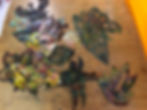Pareu Printing
- Carol Palmer
- Jul 28, 2019
- 2 min read
We are beginning the second half of our school year here in New Zealand, having just returned from a two week winter break. My family decided to go in search of sunshine during the break and visited Rarotonga - the largest of the Cook Islands.
(Sidenote: this is possibly one of the most remote destinations in the world - Rarotonga is literally in the middle of the Pacific Ocean and the island has a circumference of 32km/ 20miles. Circumference! Definatlely worth an elementary research project.)
Wherever we go, we take out love of textiles with us, so it didn't take us long to notice that many of the fabrics in the markets were printed in a similar style.

The Cook Islander's call their printing method 'pareu' printing. Pareu (pronounced paa-rio) simply means sarong, as this is the item most commonly printed in this way. However, the printing can be seen on all sorts of textiles in the Cook Islands, including curtains, cushions tablecloths and clothing.

Of course, when we were offered chance to try the local method of fabric printing, we jumped at it, and each of my children printed their own pareu or sarong.
The pattern in the printing all comes from stencil-type pieces that lie underneath the fabric.
The pieces were prepared for us already. These can be made from any thing that is easy to cut but also durable and waterproof. The tutors recommended using floor vinyl/lino.

The children arranged the pieces until they were happy with their design and then laid a piece of lightweight woven cotton fabric over them.

They chose their colours of fabric paint - the tutors suggested no more than three for best results...

...and then rolled the paint carefully and evenly all over the fabric.

The fun was in seeing the hidden patterns suddenly appear on their sarongs.

When all of the fabric was covered in paint, we carefully carried the sarongs over the fence to dry. This took about 20 minutes in the tropical heat!

The dye then has to be heat set in order to be completely wash-fast. This is simply done by giving it a good hot iron.
The process is very simple but so effective and versatile. As I watched my children working, I couldn't help thinking of all the ways we could use this to enhance Montessori education. Imagine finishing up an exploration of leaf shapes and venation patterns by printing them on a scarf, printing one of the impressionistic charts on a tote bag. or making a fabric journal cover with with a life cycle printed on it.
I'm buzzing with ideas of ways to use this, I'll post pictures to my Instagram and Facebook feeds when the children make it happen and I would love it if you shared any printing (or any handwork at all, really!) in the Facebook group: Montessori Handwork Threads. Also feel free to comment/ask questions/ post your pictures below.





